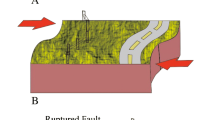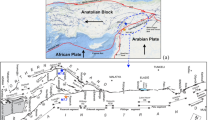Abstract
A numerical case study on the seismic behavior of embankment was carried out based on a prototype of earth embankment in Yun−Gui Railway (from Kunming City to Nanning City) in southwest of China. A full-scale model of earth embankment was established by means of numerical simulation with FLAC3D code. The numerical results were verified by shaking table test. The seismic behaviors of earth embankment were studied, including the horizontal acceleration response, the vertical acceleration response, the dynamic displacement response, and the block state of earth embankment. Results show that the acceleration magnification near the embankment slope is larger than that in internal earth embankment body. With the increase of input peak acceleration, the horizontal acceleration magnification presents a decreasing trend. The horizontal acceleration response at the top of embankment is more sensitive to the intensity of ground motion than that at the bottom of embankment. The embankment presents an obvious nonlinear-plastic characteristic when the input horizontal peak acceleration is larger than 0.3 g. The maximum residual deformation occurs in the middle of embankment slope surface instead of at the top of embankment. The upper part of embankment experiences tension failure without shear failure, and area at the bottom of embankment around the symmetry-axis of embankment mainly presents shear failure under the earthquake loading. The tension failure and shear failure repeatedly occur along the slope surface of earth embankment.
Similar content being viewed by others
References
CHIGIRA M, YAGI H. Geological and geomorphological characteristics of landslides triggered by the 2004 Mid Niigta prefecture earthquake in Japan [J]. Engineering Geology 2006, 82(4): 202–221.
COLLINS B D, KAYEN R, TANAKA Y. Spatial distribution of landslides triggered from the 2007 Niigata Chuetsu-Oki Japan earthquake [J]. Engineering Geology 2012, 127: 14–26.
CHIGIRA M, WU X Y, INOKUCHI T, WANG G H. Landslides induced by the 2008 Wenchuan Earthquake, Sichuan, China [J]. Geomorphology 2010, 118(3/4): 225–238.
DAI F C, XU C, YAO X, XU L, TU X B, GONG Q M. Spatial distribution of landslides triggered by the 2008 Ms 8.0 Wenchuan earthquake, China [J]. Journal of Asian Earth Sciences 2011, 40(4): 883–895.
GORUM T, FAN X M, WESTEN C J, HUANG R Q, XU Q, TANG C, WANG G. Distribution pattern of earthquake-induced landslides triggered by the 12 May 2008 Wenchuan Earthquake [J]. Geomorphology 2011, 133(3/4): 152–167.
LI Y, ZHOU R J, ZHAO G H, LI H B, SU D C, DING H R, YAN Z K, YAN L, YUN K, MA C. Tectonic uplift and landslides triggered by the Wenchuan earthquake and constraints on orogenic growth: A case study from Hongchun Gully, Longmen Mountains, Sichuan, China [J]. Quaternary International 2014, 349: 142–152.
WANG G H, HUANG R Q, LOURENCO S D N, KAMAI T. A large landslide triggered by the 2008 Wenchuan (M8.0) earthquake in Donghekou area: Phenomena and mechanisms [J]. Engineering Geology 2014, 182: 148–157.
XU C, XU X W, YAO X, DAI F C. Three (nearly) complete inventories of landslides triggered by the May 12, 2008 Wenchuan Mw 7.9 earthquake of China and their spatial distribution statistical analysis [J]. Landslides 2014, 11(3): 441–461.
XU C, XU X W. Statistical analysis of landslides caused by the Mw 6.9 Yushu, China, earthquake of April 14, 2010 [J]. Natural Hazards 2014, 72(2): 871–893.
LIN Yu-liang, LENG Wu-ming, YANG Guo-lin, ZHAO Lian-heng, LI Liang, YANG Jun-sheng. Seismic active earth pressure of cohesive-frictional soil on retaining wall based on a slice analysis method [J]. Soil Dynamics and Earthquake Engineering 2015, 70: 133–147
SHUKHA R, BAKER R. Design implications of the vertical pseudo-static coefficient in slope analysis [J]. Computers and Geotechnics 2008, 35(1): 86–96.
LIU R S, SHI H B. An improved pseudo-static method for seismic resistant design of underground structures [J]. Earthquake Engineering and Engineering Vibration 2006, 5(2): 189–193.
BAO X H, MORIKAWA Y, KONDO Y, NAKAMURA K, ZHANG F. Shaking table test on reinforcement effect of partial ground improvement for group-pile foundation and its numerical simulation [J]. Soils and Foundations 2012, 52(6): 1043–1061.
LIN Yu-liang. Deformation behavior of reinforced embankment slopes under seismic excitation [J]. Disaster Advances 2013, 6(7): 12–19.
LIN Yu-liang. Shaking table modeling of embankment slope response to earthquake loading[J]. Disaster Advances 2013, 6(12): 69–77.
ZHUANG H Y, YU X, ZHU C, JIN D D. Shaking table tests for the seismic response of a base-isolated structure with the SSI effect [J]. Soil Dynamics and Earthquake Engineering 2014, 67: 208–218.
LEE C J, CHEN H T, LIEN H C, WEI YC, HUNG W Y. Centrifuge modeling of the seismic responses of sand deposits with an intra-silt layer [J]. Soil Dynamics and Earthquake Engineering 2014, 65: 72–88.
MAHARJAN M, TAKAHASHI A. Centrifuge model tests on liquefaction-induced settlement and pore water migration in non-homogeneous soil deposits [J]. Soil Dynamics and Earthquake Engineering 2013, 55: 161–169.
YU Yu-zhen, DENG Li-jun, SUN Xun, LU He. Centrifuge modeling of dynamic behavior of pile-reinforced slopes during earthquakes [J]. Journal of Central South University of Technology 2010, 17(5): 1070–1078.
YU Yu-zhen, DENG Li-jun, SUN Xun, LU He. Centrifuge modeling of a dry sandy slope response to earthquake loading [J]. Bulletin of Earthquake Engineering 2008, 6(3): 47–461.
DO N A, DIAS D, ORESTE P. Three-dimensional numerical simulation of a mechanized twin tunnels in soft ground [J]. Tunnelling and Underground Space Technology 2014, 42: 40–51.
HSIEH P G, QU C Y, LIN Y L. Three-dimensional numerical analysis of deep excavations with cross walls [J]. Acta Geotechnica 2013, 8(1): 33–48.
MORTAZAVI A, ALAVI F T. A numerical study of the behavior of fully grouted rockbolts under dynamic loading [J]. Soil Dynamics and Earthquake Engineering 2013, 54: 66–72.
SCHUMACHER F P, KIM E. Evaluation of directional drilling implication of double layered pipe umbrella system for the coal mine roof support with composite material and beam element methods using FLAC 3D [J]. Journal of Mining Science 2014, 50(2): 335–348.
SHEN J Y, KARAKUS M. Three-dimensional numerical analysis for rock slope stability using shear strength reduction method [J]. Canadian Geotechnical Journal 2014, 51(2): 164–172.
WU Ai-xiang, HUANG Ming-qing, HAN Bin, WANG Yi-ming, YU Shao-feng, MIAO Xiu-xiu. Orthogonal design and numerical simulation of room and pillar configurations in fractured stopes [J]. Journal of Central South University 2014, 21(8): 3338–3344.
HUANG Y, YASHIMA A, SAWADA K, ZHANG F. Numerical assessment of the seismic response of an earth embankment on liquefiable soils [J]. Bulletin of Engineering Geology and the Environment 2008, 67(1): 31–39.
EVANGELISTA A, SANTOLO A S, SIMONELLI A L. Evaluation of pseudostatic active earth pressure coefficient of cantilever retaining walls [J]. Soil Dynamics and Earthquake Engineering 2010, 30(11): 1119–1128.
PITILAKIS D, DIETZ M, WOOD D M, CLOUTEAU D, MODARESSI A. Numerical simulation of dynamic soil-structure interaction in shaking table testing [J]. Soil Dynamics and Earthquake Engineering 2008, 28(6): 453–467.
CHOPRA A K, CHINTANAPAKDEE C. Comparing response of SDF systems to near-fault and far-fault earthquake motions in the context of spectral regions [J]. Earthquake Engingeering & Structure Dynamics 2001, 30(12): 1769–1789.
CHOPRA A K, CHINTANAPAKDEE C. Drift spectrum versus modal analysis of structural response to near-fault ground motions [J]. Earthquake Spectra 2001, 17(2): 221–234.
DAVOODI M, JAFARI M K, HADIANI N. Seismic response of embankment dams under near-fault and far-field ground motion excitation [J]. Engineering Geology 2013, 158: 66–76.
YAGHMAEI-SABEGHA S, TSANG H H. An updated study on near-fault ground motions of the 1978 Tabas, Iran, earthquake (Mw=7.4)[J]. Scientia Iranica 2011, 18(4): 895–905.
KUHLEMEYER R L, LYSMER J. Finite element method accuracy for wave propagation problems [J]. Journal of Soil Mechanics and Foundation Division 1973, 99(5): 421–427.
GHAZAVI M, RAVANSHENAS P, LAVASAN A A. Analytical and numerical solution for interaction between batter pile group [J]. KSCE Journal of Civil Engineering 2014, 18(7): 2051–2063.
MAYORAL J M, RAMIREZ J Z. Site response effects on an urban overpass [J]. Soil Dynamics and Earthquake Engineering 2011, 31(5/6): 849–855.
MANICA M, OVANDO E, BOTERO E. Assessment of damping models in FLAC [J]. Computers and Geotechnics 2014, 59: 12–20.
LIN Yu-liang, YANG Guo-lin. Dynamic behavior of railway embankment slope subjected to seismic excitation [J]. Natural Hazards 2013, 69(1): 219–235.
LIN Yu-liang, LENG Wu-ming, YANG Guo-lin, LI Liang, YANG Jun-sheng. Seismic response of embankment slopes with different reinforcing measures in shaking table tests [J]. Natural Hazards 2015, 76(2): 791–810.
Author information
Authors and Affiliations
Corresponding author
Additional information
Foundation item: Project(51308551) supported by the National Natural Science Foundation of China; Project(2012M511760) supported by the China Postdoctoral Science Foundation; Project(13JJ4017) supported by the Hunan Provincial Natural Science Foundation of China
Rights and permissions
About this article
Cite this article
Lin, Yl., Shi, F., Yang, X. et al. Numerical analysis on seismic behavior of railway earth embankment: A case study. J. Cent. South Univ. 23, 906–918 (2016). https://doi.org/10.1007/s11771-016-3138-5
Received:
Accepted:
Published:
Issue Date:
DOI: https://doi.org/10.1007/s11771-016-3138-5




